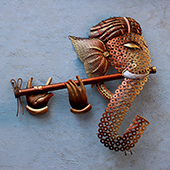Design Resource
Wrought Iron Craft - Nagpur, Maharashtra
Traditional Metal Craft
by
Prof. Bibhudutta Baraland Srikanth B.
The main raw material here is Wrought iron, with the following chemical composition; Iron 99-99.8%, Carbon- 0.05-0.25%; Manganese- 0.01-0.1%; Sulphur- 0.02-0.1%; Phosphorus- 0.05-0.2%; Silicon- 0.02-0.2%. Then the process goes step by step as stated below. Firstly, the artisan draws desired figures on a drawing paper that are chosen for sculpting. Then place the stencil design over the wrought iron sheets, drawn shapes are cut using a metal cutter. With the help of a hammer, the artisan strikes the cut-sheets to get a 2D appeal and embossing style. These different pieces are then assembled and welded together to achieve the expected figure. After this stage, a metal buffing brush and angle grinding machine are set to use for smoothening the ends and certain internal parts. Red oxide is spray-painted on the finished figures that protect the metal from corrosion and give a rich look to the craft. Followed by black enamel paint as a base colour over the remaining areas. After the base colour is dried, it is up to the artisan to decide whether to use other shades of paints or not, wherever required. Artisan often prefers to paint the ornaments of the sculptures with shimmering metallic paints. These sculptures are then let to dry and finally sold to customers.












